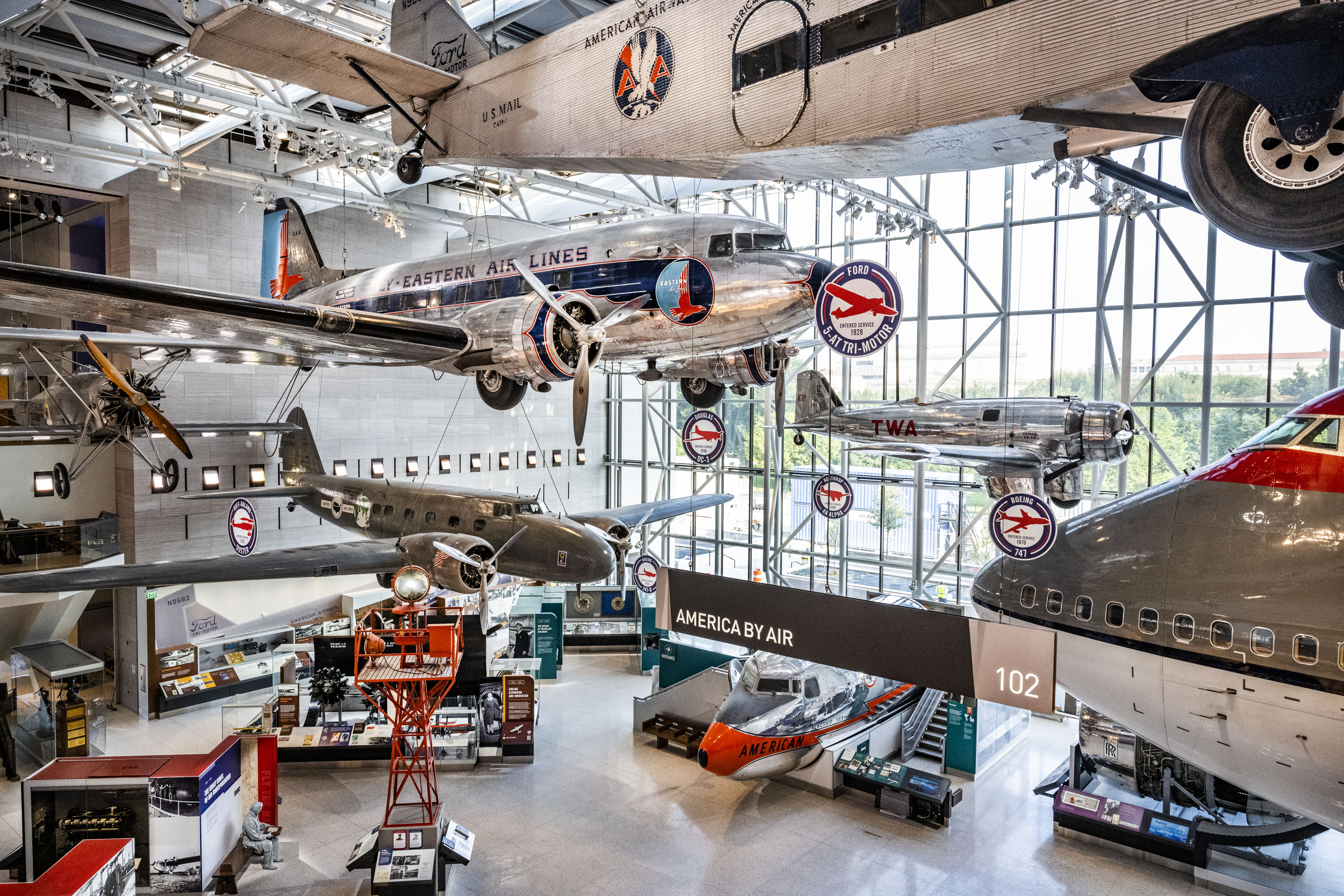“America by Air”
Title: “America by Air”
Opening: Oct. 14, 2022, National Air and Space Museum, Washington, D.C., Gallery 102
“America by Air” traces the history of air transportation in the United States. In the early 20th century, flying was new and daring, traveling by airplane was rare and the country had very few airports or airlines. But by century’s end, passengers could travel almost anywhere in the U.S. in hours. This reimagined version of the popular “America by Air” exhibition explores the origins of the airline industry, beginning with the U.S. Postal System following World War I through to the creation of jet propulsion, which changed the ease with which Americans traveled throughout the country and world. The exhibition also investigates how the commercial aviation field changed with more affordable travel for passengers and how diversity changed airline personnel.
Highlights include:
- Douglas DC-3 200: Entering service in 1936, the Douglas DC-3 became the most successful airliner in the formative years of air transportation. It was the first to fly profitably without government subsidy. More than 13,000 of the DC-3 civil and military versions were produced, U.S. and foreign built, and many are still flying.
- Boeing 747 Nose: The giant Boeing 747 revolutionized long-distance air travel. Visitors will be able to step inside the nose section from a Northwest Airlines Boeing 747-151. First flown in 1970, this 747 was the first built for Northwest and the first 747 to open service across the Pacific. It was retired in 1999.
- Huff-Daland Duster: Delta Air Lines got its start with the Huff-Daland Duster, the world’s first crop-dusting aircraft. Huff-Daland’s 18 Dusters made up the largest privately owned fleet in the world in the mid-1920s. Following the death of C.E. Woolman in September 1966, several hundred Delta volunteers restored a Huff-Daland Duster as a memorial to Delta’s founder. This aircraft is new to the gallery, having previously been on display at the museum’s Steven F. Udvar-Hazy Center in Chantilly, Virginia.
- Ford 5-AT Tri-Motor: Noisy but reliable, the Ford Tri-Motor played a major role in convincing the public that air travel was safe and practical. Affectionately known as the “Tin Goose,” the Ford Tri-Motor was the largest civil aircraft in America when it first flew Aug. 2, 1926.
- Boeing 247-D: The world’s first modern airliner, the Boeing 247 revolutionized air transportation when it entered service with United Air Lines in 1933. This innovative design launched a new generation of commercial airliners.
- Juan Trippe’s Pan American Globe: From his office in New York City, Pan American president Juan T. Trippe used this globe to plan his airline’s expansion around the world. Trippe often would stretch a string between two points on the globe and calculate the distance and time it would take to fly between them.
- Emily Howell Warner Uniform: Emily Howell Warner broke through the gender barrier to become the first American woman to fly routinely for a scheduled U.S. commercial airline. Howell was an experienced pilot when regional carrier Frontier Airlines hired her as a second officer in January 1973. She soon advanced to first officer (co-pilot) and then to captain.
- Fly the Airmail Interactive: In this decision-making activity, visitors will be faced with the same problems early airmail pilots braved when flying from New York City to Chicago. Using a touchscreen interactive, visitors will be challenged to solve the issues and successfully deliver the mail.
Sponsors: American Airlines, Delta Air Lines, United Airlines, Alaska Airlines, JetBlue, Frontier Airlines, Hawaiian Airlines, Spirit Airlines, David H. Rowe, Michael Greene, AE Industrial Partners, LP, National Air Traffic Controllers Association, Airbus
“America by Air” Curator Bio
F. Robert van der Linden
F. Robert van der Linden is the curator of air transportation and special purpose aircraft and a supervisory curator in the Aeronautics Department. He served two four-year terms as department chair, from 2007 until 2015. He is the aeronautics curator for the Boeing Milestones of Flight Hall and served as the co-lead curator for that exhibit’s latest iteration. He is also the lead curator for the award-winning “America by Air” exhibit in the Hall of Air Transportation. van der Linden is a native of Washington, D.C. He holds a Bachelor of Arts in history from the University of Denver and a Master of Arts and doctorate in modern American, business, and military history from The George Washington University. He is a member of Phi Beta Kappa, the Phi Alpha Theta history honor society and the Society for the History of Technology. He has been with the Smithsonian since 1975, starting as a volunteer before his hiring in 1977.
# # #
SI-307-2022
Alison Wood
202-633-2376
Amy Stamm
202-633-2392
Exhibition: https://airandspace.si.edu/exhibitions/america-air
Photos: https://www.flickr.com/gp/airandspace/L0ZHKm2LuM

